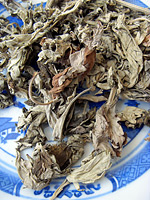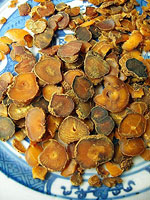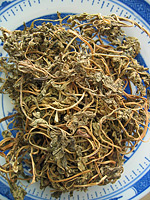Chinese Herbal Treatment for Dysfunctional Uterine Bleeding (DUB)
Menstruation is unique to women. When a woman reaches puberty, her uterus matures and her kidney essence is enriched to a certain extent. The kidneys will then produce a type of substance for promoting sexual functions, which is called tian-gui. Under the action of this substance, the conception vessel and thoroughfare vessel meridians are exuberant and flushed with abundant qi (vital energy) and blood. The excessive qi and blood will empty into the uterus and produce regular menses. In old age, the kidney essence is exhausted and tian-gui declines. The conception vessel and thoroughfare vessel gradually close and become obstructed, a woman then begins to have menstrual irregularities until menopause occurs.
According to traditional Chinese medicine (TCM), menstrual cycles are dominated by rhythmic changes of kidney qi inside the body.
Dysfunctional uterine bleeding (DUB) is characterized by irregular periods, excessive or prolonged menstrual flow, which come under TCM category of "beng-lou", literally meaning periods come with sudden flooding or trickling for a long time. TCM claims that dysfunctional uterine bleeding can be due to a wide variety of factors, such as an unhealthy lifestyle, poor diet or improper eating habits, lack of exercise, environmental factors, emotional or psychological issues, toxins and hereditary influences. The factors weaken the internal organs, affect blood and qi, and impair the conception vessel and thoroughfare vessel meridians, resulting in an uncontrollable menstrual flow.
TCM physicians usually regard dysfunctional uterine bleeding as a clinical difficulty, since the pathology usually involves several organ systems, as well as qi and blood dysfunctions, which give rise to complex conditions and hard to treat. Early diagnosis and treatment are crucial to prevent it developing into a lingering and worse consequence.
When physicians doing a consultation for dysfunctional uterine bleeding, they will ask about the specific characteristics of the bleeding, including the duration, interval, amount of bleeding, color and texture of the blood, and the accompanying symptoms during the time, other factors like age, medical history and lifestyle also take into account. The remedies are designed according to TCM disharmony patterns, and the therapeutic principles are:
| 1. |
Arrest bleeding and regulate the conception vessel and thoroughfare vessel meridians, |
| 2. |
Treat the underlying disharmony, such as to invigorate the kidneys and restore their controls over the menstruation, |
| 3. |
Restore the inside of the uterus, rebuild a normal menstrual cycle and prevent recurrence. |
 |
|
 |
|
 |
| argy wormwood leaf |
|
turmeric root-tuber |
|
motherwort herb |
Herbal prescriptions for dysfunctional uterine bleeding
For women with dysfunctional uterine bleeding, age, pregnancy and delivery history make particular changes to their bodies, and thus are important considerations for identifying the disharmony patterns. Adolescent girls tend to have kidney deficiency or over-heated blood; women in childbearing age tend to have liver stagnation or over-heated blood; while menopause women tend to have liver and kidney deficiencies or spleen weakness and qi (vital energy) deficiency. The later two age groups often combine with blood stasis too. Below are the common disharmony patterns that involve in dysfunctional uterine bleeding.
Heat in uterus
Sudden heavy vaginal bleeding or persistent vaginal blood dribbling, the blood is red or dark red colored and is thick in texture. Other signs may include mouth dryness, flushed face, dizziness, irritability, scanty urine and dry stool. The tongue is red with yellow coating, and pulse is taut and rapid. The remedy should aim to clear heat, cool blood, consolidate thoroughfare vessel and stop bleeding.
Sample prescription: Modified Clear Heat and Consolidate Menstruation Decoction plus cattail pollen, carbonized hair and motherwort herb
Stasis in uterus
Irregular periods, persistent vaginal blood dribbling, or missed periods follow by a sudden profuse vaginal bleeding, and the blood is dark-purplish and has clots. Other signs may include pain in the lower abdomen that typically feels relieved after passing the blood clots. The tongue is dark-purplish or has purple spots on it, and the pulse is taut or hesitant. The remedy should aim to activate blood, resolve stasis, consolidate thoroughfare vessel and stop bleeding.
Sample prescription: Resolve Stasis and Stop Menorrhagia Decoction plus cattail pollen and India madder rhizome (charred)
Damp-heat in uterus
Irregular periods, persistent vaginal blood dribbling, or sudden profuse vaginal bleeding, the blood is dark red or purplish red in color, thick and sticky in texture. There may also have excessive and foul vaginal discharges, pain and distention in the lower abdomen, thirst, general heaviness, and even fever. The tongue is red and covered by yellow and greasy coating, and the pulse is rolling and rapid. The remedy should aim to clear heat, resolve dampness and stop bleeding.
Sample prescription: modified Three Wonders Sargentglory Vine-stem Decoction
Qi deficiency failing to retain blood
Irregular periods, starts with profuse vaginal bleeding and then becomes persistent vaginal blood dribbling, the blood is light and thin in texture. Other signs include paleness, puffiness, fatigue, breath shortness, poor appetite, loose bowels, and emptiness and heaviness feelings in the lower abdomen, palpitations and general weakness. The tongue is pale, the pulse thready and weak. The remedy should aim to replenish qi and reinforce its ability to astringent blood, invigorate spleen and nourish blood.
Sample prescription: Consolidation and Stop Menorrhagia Decoction plus Chinese yam, bugbane rhizome and India madder rhizome (charred)
Kidney yin deficiency
Irregular periods, excessive vaginal bleeding or persistent vaginal blood dribbling, the blood is bright red color and thick in texture. Other signs include dizziness, ear ringing, warm palms and soles, irritability, lumbar and knee weakness, insomnia and night sweats, red cheeks, fatigue, general weakness and frequent urination. The tongue has little coating, and the pulse is thready and rapid. The remedy should aim to nourish kidney yin, consolidate thoroughfare vessel and stop bleeding.
Sample prescription: Modified Restore the Left (kidney) Pill (delete the achyranthes root in the formula, and add glossy privet fruit and charred garden burnet root)
Kidney yang deficiency
Irregular periods, excessive vaginal bleeding or persistent vaginal blood dribbling, and the blood is light in texture. Other signs include limb coldness, cold pain in the lumbar and knee regions, bright white complexion, profuse urination, and loose bowels. The tongue is pale and bulky, or has teeth marks on the margin, and the pulse is deep and thready in particular for the chi region. The remedy should aim to warm and invigorate kidney yang.
Sample prescription: Modified Restore the Right (kidney) Pill, (delete aconite root and cassia bark in the formula, and add astragalus root, morinda root and epimedium)
After the bleeding is controlled, intensive treatment should be continuous for three or more cycles. The consolidation therapy is aimed to resume the normal functions of the kidneys, spleen and liver, and rebuild a regular menstrual cycle. Physicians will treat according to age groups, in which adolescent girls need to invigorate the kidneys and smooth the menstrual cycle, childbearing women need to soothe the liver and nourish blood, regulate the menstrual cycle and promote ovulation, menopause women need to invigorate kidneys and spleen and prevent recurrent bleeding. Menopause women should also visit their western doctors and check up regularly to rule out other health problems.
It should be noted that menstrual disturbances can be due to different pathologies and may vary from person to person. The above patterns can appear alone or in mixed form, they are also changeable and may transform into each other over time. There is no exclusive therapy for dysfunctional uterine bleeding, each regime is customized from the independent conditions that exist within each individual; it may also need adjustment during the course of treatment so as to fit the changing condition.
|